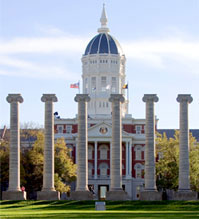Investigation of Schweitzer Hall Explosion Complete
July 9th, 2010
Mary Jo Banken,573-882-6212, BankenM@missouri.edu
COLUMBIA, Mo. — Officials from the University of Missouri have completed their investigation into the cause of the explosion at Schweitzer Hall that occurred on Monday, June 28.
The explosion occurred in the laboratory of Judy Wall, professor of biochemistry, during a routine setup of a microbiological anaerobic growth chamber. Wall and her team of researchers study anaerobic bacteria, or bacteria that cannot live in the presence of oxygen. The bacteria are able to convert toxic metals, such as uranium and other heavy metals, to less toxic forms. Wall’s research is extremely valuable to environmental agencies working to clean sites contaminated with radioactive materials or other toxic metals.
Because of the bacteria’s intolerance to oxygen, scientists must create just the right environment to study them. Wall’s team studies the bacteria in chambers that are roughly 2 cubic meters in volume.
Standard operating procedures for establishing the anaerobic environment calls for the use of nitrogen to fill the chamber. Then, small amounts of hydrogen are introduced into the chamber to remove any remaining oxygen by combining to form water. Prior to the explosion, hydrogen was prematurely introduced into the chamber and reached an explosive level. Investigators concluded that the gas was ignited by a source inside the chamber.
Two factors contributed to hydrogen being introduced prematurely into the chamber:
- Following a check for leaks in the hydrogen gas lines, the valve for the hydrogen cylinder was inadvertently left open.
- The laboratory was using a gas line with a “T-connection” that normally included a toggle switch used to prevent nitrogen and hydrogen from being simultaneously introduced into the chamber. However, a T-connection without the toggle switch was temporarily being used; thus both nitrogen and hydrogen entered the chamber simultaneously.
To prevent such accidents in the future, investigators have recommended the following actions:
- Replace the use of pure hydrogen with a 95:5 mixture of nitrogen and hydrogen.
- Following a check of gas lines for leaks, all gas cylinders should be closed and only reopened as needed.
- Use of T-connections between gases should be eliminated.
- Investigate the possibility of using hydrogen and/or oxygen sensors that could withstand a corrosive atmospheric environment.
- Give refresher training to all laboratory personnel. (Some training has already occurred.)
- Review current training, guidance materials and inspection procedures.
- Review MU’s compressed gas cylinder storage area to ensure appropriate safety procedures are in place and look for improvements.
Investigators believe that several factors helped mitigate damage and allowed normal building activities to resume quickly. These factors include:
- Wall’s laboratory group was well-organized and clean, minimizing secondary impacts from the explosion.
- Emergency information about laboratory hazards was posted outside the door for emergency responders.
- Emergency Action Plan had identified exit routes and building occupants evacuated in a timely manner.
- Utilities had been reconfigured for the building, allowing maintenance workers to cut off utility service to the affected laboratories, while keeping service to the rest of the building.
- Cooperation among the Columbia Fire Department, MU Campus Facilities, MU Environmental Health and Safety, and the MU Police Department was excellent. A history of exercises and meetings have strengthened relationships and cooperation.
Everyone involved in the accident is doing well. The one person who was admitted to the hospital was released the following evening.
Note: Previous incorrect information was circulated that a “2,000 pound hydrogen tank” exploded. The source of hydrogen was a standard compressed gas cylinder that contained about one pound of hydrogen. The tank, itself, did not explode.

